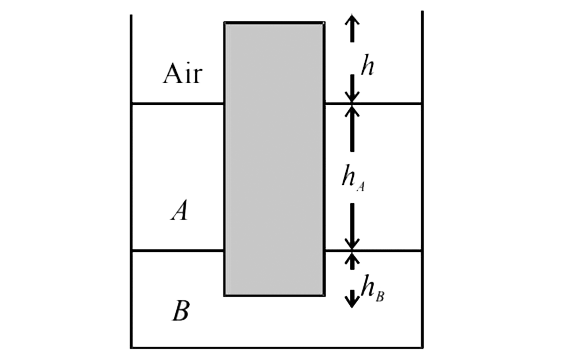A uniform solid cylinder of density 0.8g/cm3 floats in equilibrium in a combination of two non-mixing liquids A and B with its axis vertical.
The densities of the liquids A and B are 0.7g/cm3 and 1.2g/cm3, respectively. The height of liquid A is hA=1.2cm. The length of the part of the cylinder immersed in liquid B is hB=0.8cm.

(a) Find the total force exerted by liquid A on the cylinder.
(b) Find h, the length of the part of the cylinder in air.
(c) The cylinder is depressed in such a way that its top surface is just below the upper surface of liquid A and is then released. Find the acceleration of the cylinder immediately after it is released.
(a) In this problem, liquid A exerts only horinzontal force on all area elements of the cylinder in contact with it. All these force will cancel out, due to symmetry. Thus the total force exerted by the liquid A on the cylinder is zero. It is to be noted that the buoyant force acts on the horizontal bottom surface of cylinder only due to liquid B.
(b) Let a be the uniform area of cross-section of the cylinder. weight of cylinder,
W=(h+hA+hb)×a×0.8g
=(h+1.2+0.8)×a×0.8g ltbr> =(h+2)a×0.8g
The buoyant force on the cylinder due to liquids
= weight of liquid A displaced +weight of liquid B displaced
=ahAρAg+ahBρBg
=a(1.2×0.7+0.8×1.2)g=1.8ag
As the cylinder is in equilibrium , so
weight of cylinder = buoyandt force due to liquids
i.e, (h+2)a×0.8g=1.8ag
or (h+2)×0.8−1.8
or h=1.80.8−2=0.25cm
(c ) On depressing the cylinder further so as to just submerge in liquid , additional volume of the liquid B(=0.25a) is displaced. this produces an unbalanced effective upward force of bouyancy which will be responsible for the upward ac celeration of the cylinder.
The unbalanced effective upward force of buoyancy is F=0.25aρBg=0.25a×1.2×g=0.3ag
The mass of the cylinder
m=(h+hA+hB)a×0.8
=(0.25+1.2+0.8)a×0.8=1.8a
Upward ac celeration of cylinder
=Fm=0.3ag1.8a=g6.
Topper's Solved these Questions
- PROPERTIES OF BULK MATTERBOOK - PRADEEPCHAPTER - PROPERTIES OF BULK MATTEREXERCISE - NCERT Questions
73 Videos
- PROPERTIES OF BULK MATTERBOOK - PRADEEPCHAPTER - PROPERTIES OF BULK MATTEREXERCISE - Higher Order thinking skells
17 Videos
- PROPERTIES OF BULK MATTERBOOK - PRADEEPCHAPTER - PROPERTIES OF BULK MATTEREXERCISE - Conceptual Problems
103 Videos
- PHYSICAL WORLD AND MEASUREMENTBOOK - PRADEEPCHAPTER - PHYSICAL WORLD AND MEASUREMENTEXERCISE - Competiton Focus Jee Medical Entrance
18 Videos
- RAY OPTICSBOOK - PRADEEPCHAPTER - RAY OPTICSEXERCISE - Problem For Practice(a)
25 Videos
Similar Questions
A jar contains two immiscible liquids A and B with a coin at its bottom. The depths of liquid A and liquid B are 6 cm and 8 cm, respectively. If the apparent depth of the coin is 9 cm and refractive index of liquid A is 1.5, what is the refractive index of liquid B?
View SolutionA column of water 40cm height supports a 30cm column of an unknown liquid . What is the density of the liquid ?
View Solution
Knowledge Check
Choose the most appropriate options.
Argon crystallises in fcc arrangement and the density of solid and liquid Ar is 159g/cm3and1.42g/cm3, respectively. The percentage of empty space in liquid Ar isA34.84%B43.8%C23.4%D21.6%The density of a liquid at 100∘C is 8.0g/cm3 and at 0∘C is 8.4g/cm3, the coefficient of cubical expansion of the liquid is
A10−4/∘CB5×10−4/∘CC8×10−4/∘CD4×10−4/∘CAn object of relative density 0 . 75 is floating in a liquid with 500cm3 of the object inside the liquid . Find the total volume of the object, if the relative density of liquid is 1 . 0 2
A60cm3B680cm3C700cm3D740cm3
Two miscible liquids of densities 1.2gm/cm and 1.4gm/cm aer mixed with a proportion ratio of their volumes equal to 2.5: what is the density of redulting liquid?
View SolutionTwo identical tanks contain water and a liquid of density 0.8gcm−3. Pressure exerted by the liquid is equal to the pressure due to water column of 50 cm. Find the height of the liquid column in the tank ?
View SolutionTwo immiscible of densities 2.5g/cm3 and 0.8g/cm3 are taken in the ratio of their masses as 2:3 respectively find the average density of the liquid conbination.
View SolutionTwo identical containers A and B are filled with two different liquids of equal masses. The level of the liquid in container A is found to be one-fourth of the level of the liquid in container B. What is the ratio of thedensity of two liquids? If the density of he liquid in the container A is 2 " g "cm−3, then find the density of the mixture of the two liquids.
View SolutionWhen 100 drops of a liquid P is added into a liquid Q the volume of the liquid in the container which is initially filled with liquid Q doubled. Determined density of the mixture if density of the liquids P and Q are 1.5 g cm ^(-3) and 1.3 g cm^(-3), respectively
View Solution